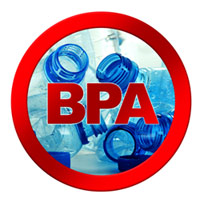Bottled water is clean and healthy – or so their producers would have you believe. After all, marketers tirelessly bombard us with picturesque images of flowing alpine springs, pristine, ice-capped mountaintops and thin, attractive models downing a pint right before biking to the pilates studio.
Make no mistake about it. Bottled water is big business, with worldwide sales projected to be between $50 and $100 billion a year. But is bottled water really any purer than ordinary tap water filtered in your home? Well, considering that many top brands are actually just filtered tap water, it's safe to say that bottled water is often times more pure hype than pure water.
Let’s acknowledge - that bottled waters are usually overpriced, sometimes unsanitary, and always damaging to the environment.
What contaminants will be included in bottled water?

Plastic Chemicals
Most small 16-20 oz bottled waters are made from polyethylene terephthalate (PET), which can leach harmful plastic chemicals and hormone disruptors into the water. Larger bottled waters don't fare any better. In 2000, Consumer Reports found that 8 out of 10 large 5-gallon jugs they tested left the dangerous endocrine disruptor bisphenol A (BPA) in the water. BPA has been linked to breast cancer, prostate cancer and diabetes as well as reproductive development disorders.
Worse yet, plastic leaching increases with age and heat so storing bottled water in your garage is a big No-No!
Harmful Bacteria
How would you like to drink a nice colony of bacteria after your morning workout? When the NRDC (National Resources Defense Council) tested more than 1,000 water bottles, including 103 bottled water brands, the organization found that 1/3 of the brands contained arsenic, bacteria and synthetic organics exceeding allowable limits.
And the NRDC isn't alone. Canada's C-crest Laboratories, a pharmaceutical testing company in Montreal, found that 70% of the dozen bottled water brands it tested had high levels of heterotrophic bacteria, which can be pathogenic and cause infectious diseases like E. coli. The United States Pharmacopoeia says the heterotrophic bacteria in drinking water should not exceed 500 colony-forming units (CFUs) per milliliter, yet the highest recorded level from the sample was 80,000 CFUs per milliliter.
Other than harmful chemicals and contaminants, bottled water also has the following shortages-Poor Quality
The Environmental Protection Agency (EPA) has strict guidelines for tap water but does not oversee bottled water. Instead, bottled water is regulated by the Food and Drug Administration (FDA), which has weaker regulations and applies the EPA's rules only selectively to bottled water. Also, the FDA only inspects bottled water if it crosses state lines, and approximately 70% of bottled water never does, making it exempt from FDA oversight.
The truth is, bottled water taste and quality can range from very good to very bad depending on the brand, and that is a serious problem for the industry. Unfortunately, like a box of chocolate, you never know what you will get.
Too Expensive
Bottled water can cost 500 to 3,000 times more than tap water. So, if you buy a 20 ounce name brand for $1 then that works out to 5 cents an ounce, whereas municipal water costs about 1 cent per gallon. Since most bottled water is simply just filtered tap water, it makes much more sense to just purchase a water filter and purify your water at home. Adding a quality water filtration system will only increase that costs up to about 2-3 cents per gallon and it will give you clean water that tastes just as good but at a much lower cost.

Do you really want to pay that much for something that literally falls from the sky?
Environmentally Unfriendly
Our addiction to drinking bottled water contributes greatly to global pollution. Despite well-intentioned recycling campaigns, 85% of PET bottles are either thrown away, tumbling around as litter, or ebbing in the ocean, posing a threat to marine life that sometimes mistakes the garbage for food. In 2006 the production of bottled water used the equivalent of more than 17 million barrels of oil, releasing more than 2.5 million tons of carbon dioxide.
What can you do? Switch your plastic water bottle for a BPA-free stainless steel or aluminum water bottle. And fill it up with filtered water, which has a more consistent, fresh, and pleasant taste when compared with stale bottled water with a hint of plastic.
Alternatives to Bottled Water
Tap Water
Because municipal water systems fall under the jurisdiction of the EPA, tap water is regularly tested for bacteria and toxins. However toxic chemicals like chlorine, chloramines, and fluoride are routinely added to tap water and water contamination can occur at a thousand different entry points during the trip from the water plant to your home. This is why every family should seriously consider installing a water purification system in their home for drinking water.
Home Water Purification
Reverse osmosis systems are a great water purification choice because they can produce an unlimited amount of ultra-pure drinking water from the comfort of your own home. Reverse osmosis removes up to 99% of organics, chemicals, heavy metals, bacteria, and radioactive pollution to produce fresh delicious drinking water at a fraction of the price of bottled water. So bottle your water at home with a reverse osmosis filter to protect the money in your pocket, the health of your family, and the beauty of our environment.



